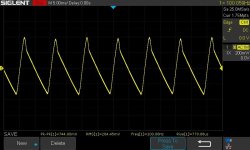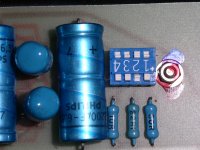Possibly polyester's from Selectronic
If true, replacing them with WIMA polypropylene should bring audible improvement for a few $.
I'd expect less mid and more refined hi.
If true, replacing them with WIMA polypropylene should bring audible improvement for a few $.
I'd expect less mid and more refined hi.
Well if you expect that, then thats's probably what you will hear..I'd expect less mid and more refined hi
My two cents (or Rappen): More likely, there will be no measureable (or audible) difference, regardless of which type of film cap is used for decoupling - as long as they are about the same size capacitance.
...
A better place to add decoupling, would probably be on the output boards, where it is most needed.
-But if it ain't broke (in original form), maybe don't fix it? 🙂
I ordered some caps for trial. Alot of people report positive results with the outlined installation method. I will provide an update when I have them installed.
... there will be no measureable (or audible) difference...
Of course, of course, everything sounds the same...
... to those who don't listen 🙂
Actually, polyester and polypropylene caps do measure differently, and each has its own sonic signature. This is known and published for a long lime, do a search. Furthermore, the way the cap is built is also important. I think I uploaded a short video demonstrating the piezo electric effect with some cheap MKP caps over in the CTC thread, maybe it's still there.
Yes, I don't question that, when measuring the capacitor seperately.polyester and polypropylene caps do measure differently
But once the 4,7 uF MKT/MKP is parallel with 22.000uF, it's a different situation.
IMHO, if the amplifier is stable as-is, I don't think adding 4,7uF will do anything (but probably won't hurt).
However, if the SA/1 was designed now, I imagine it would have more decoupling, especially on the amp. PCB, close to the output transistors.
I have no nothing more to add, as the subject is well covered in other threads here.
I installed Mundorf silver/oil 0.1uF as bypass caps. It changed the sonic signature significantly. More focus on treble and more overall air, bit harsh right at the beginning, but I read this will smooth out after burn in. Let’s see in 100hours. Much bigger change compared to cable upgrades and all the other tweaks one can do.
Hi Visioneer, I don't mean to insult you or spoil your enjoyment of your very nice amplifier, but this is such a text book case of expectancy bias, I have to comment on it: As Zen Mod politely hints at, it is very very unlikely, that a 100nF film cap in parallel with 47mF makes any difference. That's simply not how it works.It changed the sonic signature significantly.
Had you used e.g. 10uF, then there would at least be the theoretical possibility of an actual change or improvement.
A question: Do you have an oscillioscope?
I would be very interested to know how much 100hz residual ripple you have on this "beefed up" power supply.
I'm currently doing some servicing on a SA/3 in original condition, and I think the ripple level is too high. There is also some audioble hum on the speakers.
See attached measurement, showing app. 750mV Peak to peak measured on the caps:

I would be very interested to know how much 100hz residual ripple you have on this "beefed up" power supply.
I'm currently doing some servicing on a SA/3 in original condition, and I think the ripple level is too high. There is also some audioble hum on the speakers.
See attached measurement, showing app. 750mV Peak to peak measured on the caps:

I am unfortunately not a DIYer, just someone that enjoys the music and the gear. So no measuring equipment.
Bottom line the caps do make a substantial positive difference to the sound that can be easily heard.
the hum is reduced to a minimum with the filters.
Bottom line the caps do make a substantial positive difference to the sound that can be easily heard.
the hum is reduced to a minimum with the filters.
Last edited:
Agree, I typically (if used at all) go for 47uFplay with something more substantial - from 4u7 upwards
100n is in realm of placebo
It is completely unlikely to have an effect due to the total capacity increase, I expect any change is due to the fact the big E-caps are coils at higher frequencies and MKT or MKP is actually a capacitor - but I have not dived deeply into the actual measurements and the effect of the hf decoupling is as expected greatly dependent on the amplifier design.
More focus on treble
Yup, classic SIO sound. I find it intolerable except in tweeter crossovers. Overall not a huge fan of cap bypassing in PS; rather use main capacitors with a desirable sonic character than try fixing it with addons.
just for pool of tricks : I'm finding addition of motor run caps as bypass (47 to 100uF per rail, depending of space) very beneficial for sound
excluding case - I have some (small stash NOS) Philips cans of 68mF/25V, with ripple declared of zillion amps@20KHz
with these in PSU of my own SissySIT, I can't hear any difference , with or without motor runs
excluding case - I have some (small stash NOS) Philips cans of 68mF/25V, with ripple declared of zillion amps@20KHz
with these in PSU of my own SissySIT, I can't hear any difference , with or without motor runs
I know exactly what cap type that is ZM - I have these in 47mF/63V among other sizes, and have been facing the same "problem" 😊
They are unfortunately not produced anymore - also not under the subsequent names.
They are unfortunately not produced anymore - also not under the subsequent names.
I unfortunately cannot remember the exact values I measured a couple of months ago on a black SA/3 - but I am sure they were not that high. And it certainly was lower than that after the new 100k caps were installed. No hum except from the usual low hum from the mains transformer.A question: Do you have an oscillioscope?
I would be very interested to know how much 100hz residual ripple you have on this "beefed up" power supply.
I'm currently doing some servicing on a SA/3 in original condition, and I think the ripple level is too high. There is also some audioble hum on the speakers.
See attached measurement, showing app. 750mV Peak to peak measured on the caps:
View attachment 1020678
Are you talking about these, the dark blue axial ones?...
excluding case - I have some (small stash NOS) Philips cans of 68mF/25V, with ripple declared of zillion amps@20KHz
with these in PSU of my own SissySIT, I can't hear any difference , with or without motor runs
Sadly, they have some reliability issues: I have some that went short in my mckinnie MC prepreamp (designed by JC, built by RO)
Attachments
I'm pretty sure, that's not the type of Philiips caps Zen Mod refers to - more like some big old "beer cans" with high ripple rating.
Hi Norgaard, is 100k = 100mF? If so, did you change to a 4 capacitor setup (with possible CRC), or just use two big ones?after the new 100k caps were installed
I am thinking of doing away with the simple two large caps design, and replacing them with two stacked PCBs, so each channel gets its own CRC power supply (with shared transformer of course). Looks like it would fit quite nicely, and each channel could get almost 100mF.
But this will also require a soft start circuit, which makes it a bit mere complex
Yes I should have written 2x 100mFHi Norgaard, is 100k = 100mF? If so, did you change to a 4 capacitor setup (with possible CRC), or just use two big ones?
I am thinking of doing away with the simple two large caps design, and replacing them with two stacked PCBs, so each channel gets its own CRC power supply (with shared transformer of course). Looks like it would fit quite nicely, and each channel could get almost 100mF.
But this will also require a soft start circuit, which makes it a bit mere complex
So two big cans, low ESR, drop in replacement, all the cabling kept original and to the naked eye; a close to original setup - just as the owner preferred it.
Maybe also considering re-sale value, as these are becoming collectors items (and rightfully so).
Added a soft start (inrush protection with relay) not doing so will for sure burn the power switch.
This almost eliminated any thumps at power up on both SA/1's and SA/3.
No noise problems in our setups, so no CRC consideration = no extra voltage drop.
But I do follow you through on the CRC and split, which could also be an Y split as on the Firstwatt.
Admittedly I'd then rather go straight for the SA/2's or 1's
If you don't need the extra power then the SA/3 holds its own....... 😉
N.B. I have always replaced the tantalum caps on the driver boards, they have been measuring ok, but just don't want to take any chances on those while having everything apart - And do check that the heatsinks are not in anyway lose and the paste still in place...
- Home
- Amplifiers
- Pass Labs
- Threshold SA/1 hiss
